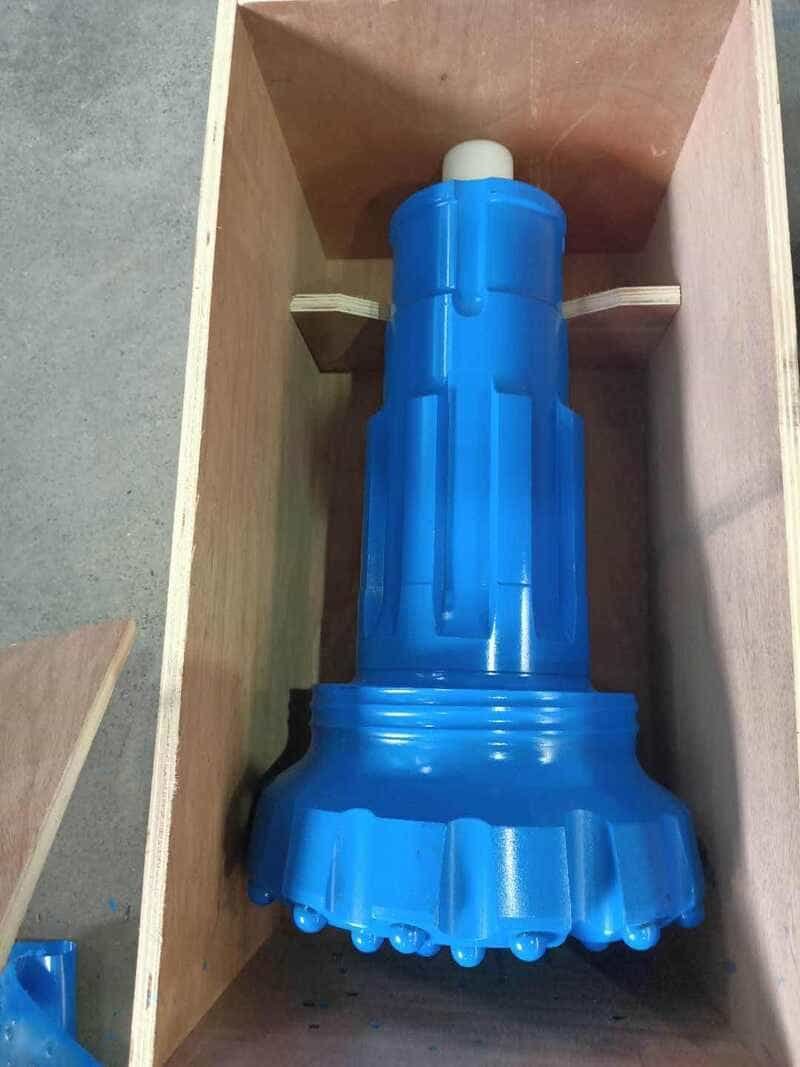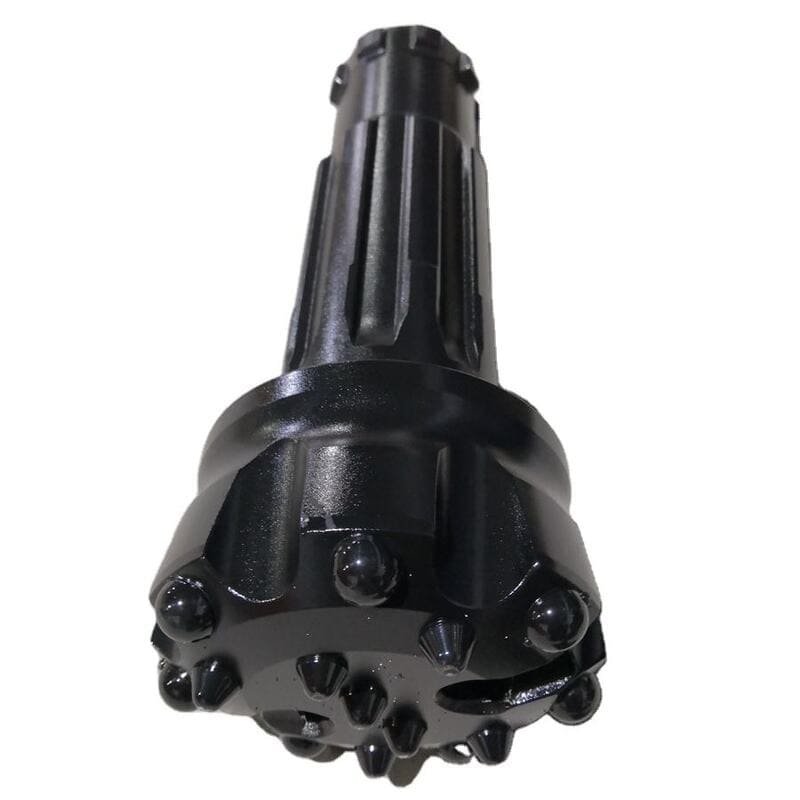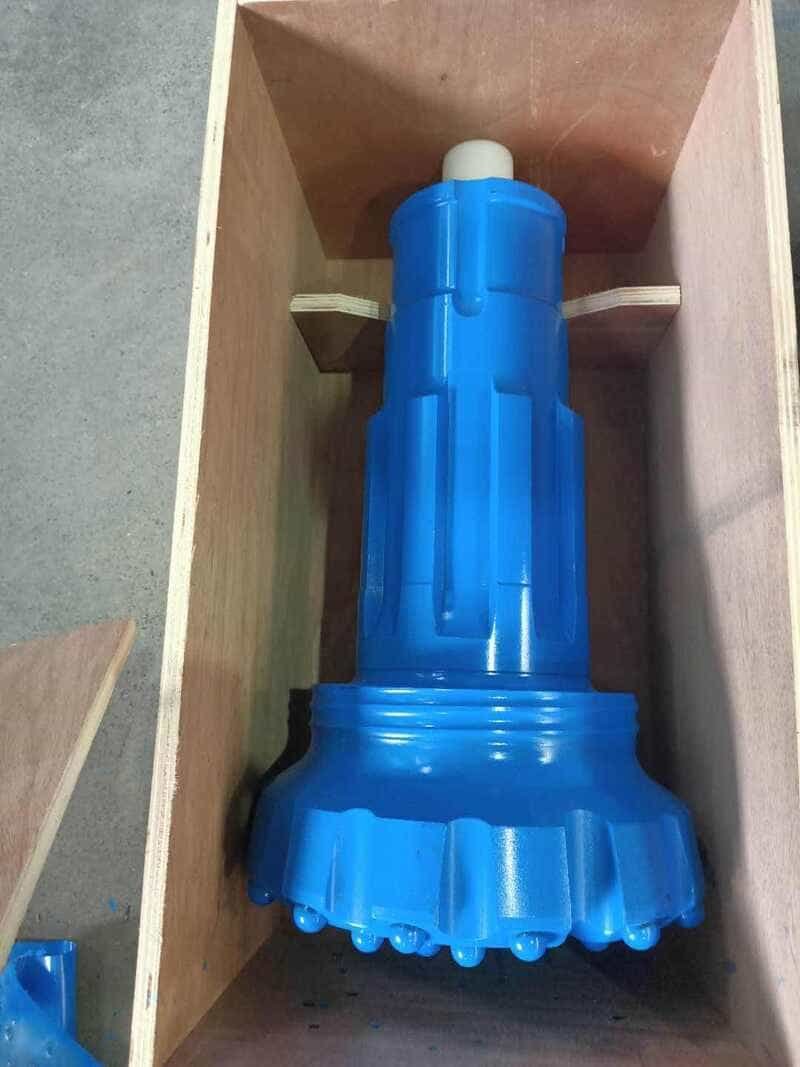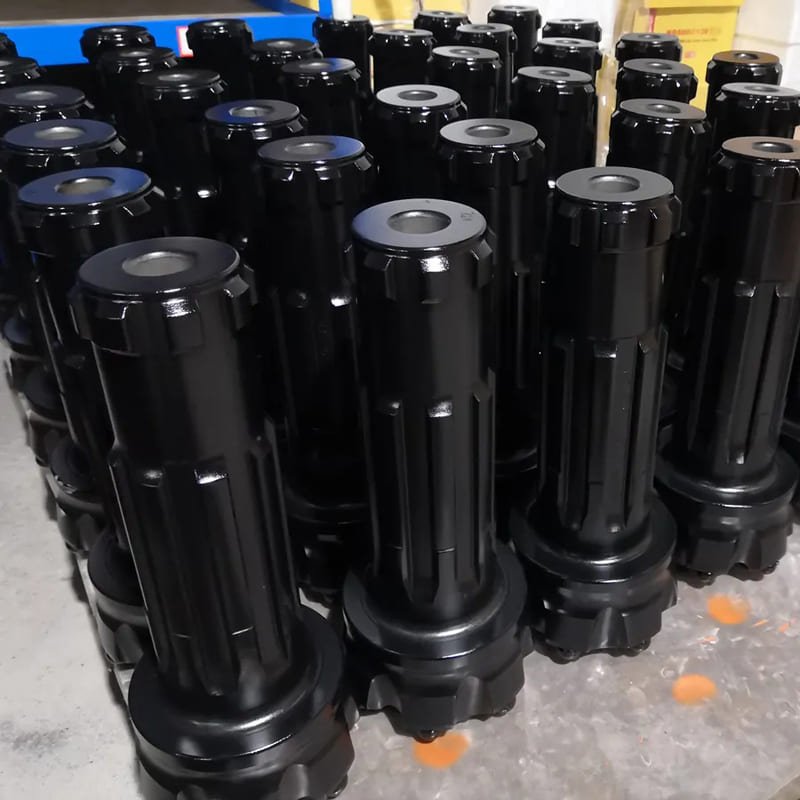Have you ever wondered what makes DTH drill bits a game-changer in the drilling world?
DTH drill bits stand out due to their unique integration with a DTH hammer, which delivers high-frequency impact forces directly at the bit face. This design is particularly effective in hard rock formations, offering faster penetration and straighter holes than traditional rotary drill bits.
When I first got into drilling, I was amazed by how DTH drill bits seemed to make the impossible possible. Unlike other bits, they work like a relentless percussion instrument, hammering away at tough rock with incredible precision. This isn't just about brute force—it's about the art of drilling smartly and efficiently. The magic happens because these bits team up with a DTH hammer, giving them an edge in speed and accuracy that I hadn't seen before.
If you’ve ever been on a site where the rock feels like it’s fighting back, you’ll know what I mean. These bits don’t just push through; they glide in, creating straighter paths with less deviation. It’s like having a trusty sidekick that never lets you down when the going gets tough. And just when you think they can't get better, the low air consumption feature steps in, saving energy while boosting performance.
What really seals the deal for me is their versatility. Whether it's for mining, quarrying, or even water well drilling, they adapt with ease. Plus, there’s the customization—tailoring button size and face design to suit specific geological conditions. It's this adaptability that makes them indispensable in challenging environments.
Every time I see a DTH bit in action, it reminds me why they’re favored in demanding settings. They're not just tools; they're problem solvers that redefine what we can achieve in drilling.
DTH drill bits use a DTH hammer for high-frequency impacts.True
DTH bits work with a hammer directly above, delivering impacts.
DTH drill bits have higher air consumption than top hammer drilling.False
DTH bits generally consume less air than top hammer methods.
How Does the Structure of DTH Drill Bits Enhance Performance?
Have you ever wondered what makes DTH drill bits so effective in tough drilling conditions?
DTH drill bits enhance performance through a robust structure featuring a steel body and tungsten carbide buttons, designed to work seamlessly with a DTH hammer for efficient energy transfer and high penetration rates in hard rock formations.

The Unique Composition of DTH Drill Bits
I remember the first time I watched a DTH drill bit in action; it was like witnessing an orchestra of engineering precision. Unlike those traditional drill bits that rely solely on rotation, these bits are all about power. At the heart of their performance is a steel body decked out with tungsten carbide buttons. These aren't just any buttons—they're meticulously arranged to make the most contact with the rock surface, ensuring that every ounce of energy is put to good use. It's this strategic setup that allows for efficient energy transfer1 during drilling operations, making them a go-to choice for tough terrains.
Working Synergy with DTH Hammers
The real magic happens when DTH drill bits team up with DTH hammers. Picture this: the hammer is right above the bit, meaning every strike delivers its full force directly where it's needed. It reminds me of when I used to play baseball as a kid—when you hit the sweet spot, the ball just flies. That's what happens here; the bit rotates while the hammer strikes, letting those carbide buttons do their job by breaking down even the hardest rocks. This percussion-based approach is a game-changer, especially when rotary methods fall short.
Enhanced Stability and Hole Straightness
Have you ever tried to drill a straight hole only for it to veer off course? Frustrating, right? DTH drill bits shine here. Their design ensures that the impact force hits right behind the bit, keeping it on track and delivering straighter boreholes. It's like having a steady hand guiding you—ideal for precision-demanding tasks in mining or construction projects2.
Customization for Varied Applications
One of my favorite things about DTH drill bits is how customizable they are. Depending on what you're working with—be it dense rock or something more forgiving—you can tweak everything from button size and arrangement to face design and carbide types. This level of customization means you can fine-tune your tools to suit any project, whether it's mining or drilling a new water well.
Efficiency in Air Consumption
Let’s talk about air consumption for a moment. Compared to other methods, DTH drill bits often sip rather than gulp air, which can save a lot on operational costs. This efficiency is all thanks to their direct energy transfer mechanism, cutting down on the power needed from external sources like air compressors. This design not only supports sustainable practices3 but also makes me feel like I'm contributing to a greener planet.
DTH drill bits have higher air consumption than top hammer bits.False
DTH drill bits generally have lower air consumption compared to top hammer drilling.
DTH drill bits are more efficient in hard rock formations.True
They have higher penetration rates and efficient energy transfer in hard rock.
How Do DTH Drill Bits Work?
Ever wondered how DTH drill bits tackle tough rock formations with ease?
DTH drill bits use a hammer to deliver rapid, high-frequency impacts directly to the rock. This percussion action, paired with bit rotation, efficiently breaks up hard materials. Compressed air clears away debris, boosting drilling efficiency, particularly in challenging geological conditions.

Structure and Functionality of DTH Drill Bits
I remember the first time I saw a DTH drill bit in action. It was during a site visit to a quarry, and the sheer power behind these tools was mesmerizing. At the heart of these bits is a sturdy steel body dotted with tungsten carbide buttons or inserts. The design ensures4 that the bit can withstand the relentless pounding of drilling operations.
The connection between the bit's shank and the hammer is like a well-coordinated dance. The hammer, positioned just above the bit, delivers those rapid-fire impacts that are crucial for breaking through tough rock. It's fascinating how such controlled chaos results in efficient drilling.
How DTH Drill Bits Operate
The magic happens with the hammer's percussion forces. Imagine striking a rock with a small yet powerful hammer repeatedly while it spins. That's what these bits do. The tungsten carbide buttons make contact with the rock surface, shattering it bit by bit. This combination of percussion and rotation leads to efficient rock fragmentation.
Compressed air plays an unsung hero's role here. It travels down the drill string, emerging from the bit to whisk away debris, maintaining drilling efficiency and preventing blockages—a bit like trying to dig a hole in sand without clearing away the pile.
Advantages in Hard Rock Drilling
When dealing with hard rock, these bits are in their element. Their design allows them to penetrate stubborn surfaces at impressive rates—demanding geological conditions5. I once chatted with a seasoned engineer who likened it to slicing through butter—a testament to their efficiency in transferring energy right where it's needed.
Another standout feature is how straight they keep boreholes. By applying force directly behind the bit, deviation is minimized, ensuring straighter boreholes even in hard rock formations—essential for mining and construction projects where precision isn't just preferred—it's essential.
Customization for Specific Applications
What I find most intriguing about DTH drill bits is their adaptability. Depending on the task at hand, you can tweak everything from button size and arrangement to face design (such as concave or convex) and carbide type (like dome or ballistic). This level of customization ensures these bits can handle any challenge thrown their way—whether it's mining, quarrying, or construction—geological conditions6.
These tailored solutions keep them at the forefront of drilling technology, making life easier for engineers and geologists alike. It's like having a personalized toolkit designed to conquer whatever geological puzzle you're faced with.
DTH drill bits have higher air consumption than top hammer.False
DTH drill bits generally have lower air consumption compared to top hammer.
DTH drill bits are less efficient in hard rock formations.False
DTH drill bits excel in hard rock due to better energy transfer and penetration.
Why Are DTH Drill Bits More Efficient in Hard Rock Formations?
I remember the first time I saw a DTH drill bit in action; it was like watching a master craftsman effortlessly chisel through marble. So, what makes these drill bits so effective in hard rock formations?
DTH drill bits excel in hard rock due to their ability to deliver high-frequency impacts with minimal energy loss, ensuring faster penetration and precise hole alignment. This makes them perfect for tackling tough geological challenges efficiently.

High-Frequency Impact Forces
Let me take you back to a project where I witnessed the raw power of DTH drill bits. Picture a stubborn granite formation that seemed impenetrable at first glance. But with the high-frequency impact forces of the DTH drill bit, it was like watching an artist carve through stone. The hammer's rapid blows directly onto the bit shattered the rock surface, making what seemed like a Herculean task look surprisingly manageable. Compared to traditional rotary methods, which felt like pushing against a brick wall, this was a revelation. It's that energy efficiency7 that makes all the difference.
Efficient Energy Transfer
Another unforgettable moment was during a cost-sensitive project where every ounce of energy counted. The DTH system was incredible because it minimized energy loss by delivering the hammering action right above the bit. I could see how this direct approach kept most of the energy focused on breaking the rock, unlike top hammer drills, where energy seemed to fade as it traveled through longer distances. It was enlightening to explore different techniques and see firsthand how energy dynamics8 affect efficiency in drilling.
Hole Straightness and Precision
Precision often feels like a luxury in drilling, but with DTH drill bits, it's a given. I vividly recall an instance where the project's success hinged on maintaining an exact alignment over several meters. The direct impact force right behind the bit ensured a straight path, almost like drawing a line with a ruler, while rotary bits tended to veer off course. For projects demanding precision, like mining or construction, DTH bits are undeniably reliable.
Lower Air Consumption
In my experience, keeping operational costs down is always a priority. DTH drill bits shine here too by consuming less compressed air than top hammer systems. This not only cuts down on energy use but also prolongs equipment life due to reduced wear and tear. For industries looking for cost-effective drilling solutions9, this translates into significant savings over time. It's fascinating how a simple change in technology can lead to such substantial advantages.
DTH drill bits use a rotary drilling method.False
DTH drill bits use percussion-based methods, not rotary.
DTH drill bits are efficient in hard rock formations.True
They offer higher penetration rates and efficient energy transfer.
How Do DTH Drill Bits Ensure Straighter Holes?
Ever wondered how a simple tool could change the game in drilling, ensuring straighter holes even in tough rock? Let me walk you through my journey with DTH drill bits.
DTH drill bits ensure straighter holes by delivering impact force directly behind the bit, minimizing deviation in hard rock formations. Their unique design and working principle enhance precision and efficiency, making them ideal for tough drilling conditions.

The Unique Design of DTH Drill Bits
I remember the first time I handled a DTH drill bit; it was like holding a key to a new world of precision. These bits are designed to keep the drilling path as straight as a laser beam. The magic lies in their structure. They connect seamlessly with a DTH hammer placed just above the bit, which ensures that the impact is delivered directly to where it's needed. Imagine trying to drive a nail into wood without holding the hammer close enough—it's not going to work well, right? That's why this design is genius; it keeps the bit moving along a true path, reducing any chances of it wandering off.
The tungsten carbide10 buttons on these bits remind me of the time I played with Lego as a kid—everything has its place and purpose. These buttons are meticulously arranged to handle the stress and wear from pounding through solid rock. It’s not just about durability; it's about maintaining a steady pace without drifting.
Working Principle and Impact Force
When I first saw a DTH drill bit in action, I was amazed at how little it relied on brute strength alone. It’s more like an art form. The hammer delivers high-frequency impacts right at the bit itself, unlike traditional drills that apply lateral pressure. It's like comparing a precise martial arts move to a clumsy shove. This precision means each hit is strong enough to crack through rock without veering off course.
And let me tell you, the compressed air system within the DTH drilling setup11 is like having an invisible helper clearing away debris as you work. It’s crucial because any buildup can make the bit wander off, but here, it's like someone constantly sweeping the path clean.
Application in Hard Rock Formations
I've always been fascinated by how different tools adapt to different challenges. DTH drill bits are like seasoned mountaineers when it comes to hard rock. They don’t lose energy or direction; instead, they maintain a direct line, even when the going gets tough. Unlike top hammer systems, which lose some steam as energy travels down the rod, DTH systems are all about delivering consistent power right where it's needed.
Moreover, there’s customization—like picking out just the right gear for an expedition. You can choose different button sizes12 and face designs to match specific rock conditions. This flexibility makes them perfect for diverse projects, whether you're digging for minerals or laying foundations.
Versatility and Efficiency
One thing that never fails to impress me is how versatile these bits are. They're not just about making straight holes; they're about doing it efficiently and economically. They use less air compared to other methods, which is like saving fuel on a long road trip—essential when you’re managing resources on big projects.
So if you're looking to tackle complex terrains with precision and reliability, getting to know DTH drill bits might just be your best move. Their thoughtful design and reliable operation are what make them stand out in the world of drilling.
DTH drill bits use rotary drilling methods.False
DTH drill bits use percussion-based methods, not just rotation.
DTH drill bits excel in hard rock formations.True
They have higher penetration rates and efficient energy transfer.
How Do DTH Drill Bits Achieve Greater Air Efficiency?
I remember the first time I came across DTH drill bits; their air efficiency was a game-changer in my work.
DTH drill bits excel in air efficiency due to their unique design that works with a DTH hammer, allowing efficient energy transfer and effective debris clearance, all while minimizing air consumption.

Understanding DTH Drill Bits
When I first learned about DTH (Down-The-Hole) drill bits, it felt like unlocking a secret in drilling efficiency. These drill bits work hand-in-hand with a DTH hammer, which sits right above the bit. This setup delivers high-frequency impacts directly onto the material, making sure the energy is used where it counts. Unlike other methods that lean heavily on rotation, DTH uses both rotation and percussion to power through tough rock formations.
Design and Energy Transfer
The way DTH drill bits are designed blew my mind the first time I saw it. With their tungsten carbide buttons and distinct shank structure, they seemed crafted for precision. The percussion force from the hammer hits exactly where needed, minimizing energy loss. It's like having a precision tool that uses just enough air to get the job done better than anything else I've used.
Air Usage and Debris Clearance
In my experience, compressed air in DTH drilling serves dual purposes—powering the hammer and clearing debris. The smart design of these bits ensures air is used efficiently for both tasks. This keeps the drilling path clear and operations smooth, crucial for maintaining speed and efficiency. The reduced air consumption not only makes DTH eco-friendly but also kinder on the wallet over time.
Comparisons with Other Methods
Top hammer drilling often demands higher air pressure and volume, something I've found challenging when air supply is limited or expensive. DTH systems, on the other hand, are tuned to use just the right amount of air for optimal performance. This has been particularly advantageous in projects where budget constraints were tight.
Versatility in Application
I've come to appreciate how versatile DTH drill bits are. They can be customized to fit different geological conditions, which is a lifesaver in diverse terrains. Whether it's adjusting button size or face design, these bits can be tailored perfectly for the task. This customization further boosts air efficiency, ensuring the tool matches the job at hand. Learn more about drill bit customization13 for various applications.
Real-World Benefits
From my time in mining and construction, I've seen professionals lean towards DTH drill bits because of their reliability in tough conditions. Their ability to maintain lower air consumption while delivering high penetration rates is ideal for projects where every ounce of efficiency counts. Discover how energy-efficient drilling techniques14 can transform project outcomes.
DTH drill bits have lower air consumption than top hammer bits.True
DTH drill bits are more efficient in air use, reducing overall consumption.
DTH drill bits are primarily used for water well drilling only.False
They are used in mining, quarrying, and construction, not just wells.
How Can DTH Drill Bits Be Customized for Specific Needs?
Ever found yourself staring at a drilling site, wondering if there's a better way to tackle that stubborn rock?
DTH drill bits can be tailored by tweaking button size, face design, and carbide insert types, aligning them perfectly with different geological and project needs.

I remember the first time I stood on a rocky construction site, feeling a mix of excitement and trepidation. The idea that a drill bit could be custom-made to tackle the specific challenges of the terrain was mind-blowing. Customization isn't just a luxury; it's a necessity for achieving efficiency and precision.
Understanding the Role of Button Size and Arrangement
The button size and arrangement on a DTH drill bit are like the secret recipe to cracking open a stubborn rock. Larger buttons can penetrate harder rocks, while smaller ones provide better precision in softer materials. Imagine arranging these buttons in just the right pattern—it's like playing a game of Tetris but with rocks, enhancing the bit's ability to break rock efficiently. This knowledge is invaluable, especially when dealing with varied geological layers in mining operations15 or construction projects16.
Exploring Face Design Variations
Choosing the right face design for a DTH drill bit feels like picking the perfect pair of shoes for a hike. Will it be concave, convex, or flat? Each has its own unique flair: concave designs help center the bit in soft formations—like finding your balance on sand; convex faces are tough enough to tackle hard rock with their enhanced cutting action; and flat faces offer that versatile, all-terrain capability. It’s all about understanding what your project demands, be it quarrying17 or water well drilling18, and picking accordingly.
Tailoring Carbide Insert Types
The type of carbide insert used in your DTH drill bit is akin to choosing the right tool for carving a masterpiece. Dome-shaped inserts last longer and thrive in abrasive conditions; semi-ballistic ones strike a balance—perfect for medium-hard rock—and ballistic inserts race through soft to medium formations with rapid penetration. This choice can make or break your project, especially in fields like oil and gas exploration19, where each rock layer presents its own set of challenges.
Every time I think about these customizations, I’m reminded of how these seemingly small adjustments can lead to big breakthroughs on-site. Tailoring DTH drill bits isn’t just about fitting the task; it’s about transforming challenges into opportunities for success.
DTH drill bits are used with rotary drilling methods.False
DTH drill bits use percussion-based methods, not rotary drilling.
DTH drill bits have lower air consumption than top hammer bits.True
They are more efficient in air usage compared to top hammer drilling.
Conclusion
DTH drill bits uniquely combine high-frequency impacts and efficient energy transfer, excelling in hard rock drilling with customizable designs for enhanced precision and lower air consumption compared to traditional methods.
-
Discover how energy transfer enhances DTH drilling performance. ↩
-
Explore the benefits of using DTH drill bits in construction. ↩
-
Learn about sustainable practices in modern drilling technology. ↩
-
Learn about DTH drill bit design advantages. ↩
-
Discover why DTH bits excel in hard rock. ↩
-
Explore how DTH bits are tailored for tasks. ↩
-
Understand the significance of energy efficiency in reducing operational costs. ↩
-
Learn how various drilling techniques influence operational effectiveness. ↩
-
Explore economical options for drilling in challenging geological conditions. ↩
-
Discover how tungsten carbide enhances durability and accuracy. ↩
-
Learn about efficient setups that improve drilling precision. ↩
-
Explore how customization enhances performance in different terrains. ↩
-
Explore how customized designs improve drilling efficiency. ↩
-
Learn strategies to enhance drilling project efficiency. ↩
-
Explore tailored bit options used in challenging mining environments. ↩
-
Discover how tailored bits improve efficiency in construction tasks. ↩
-
Learn about bit customizations that enhance quarrying productivity. ↩
-
Find out how customization aids in efficient water well drilling. ↩
-
See how custom bits tackle diverse challenges in oil exploration. ↩








